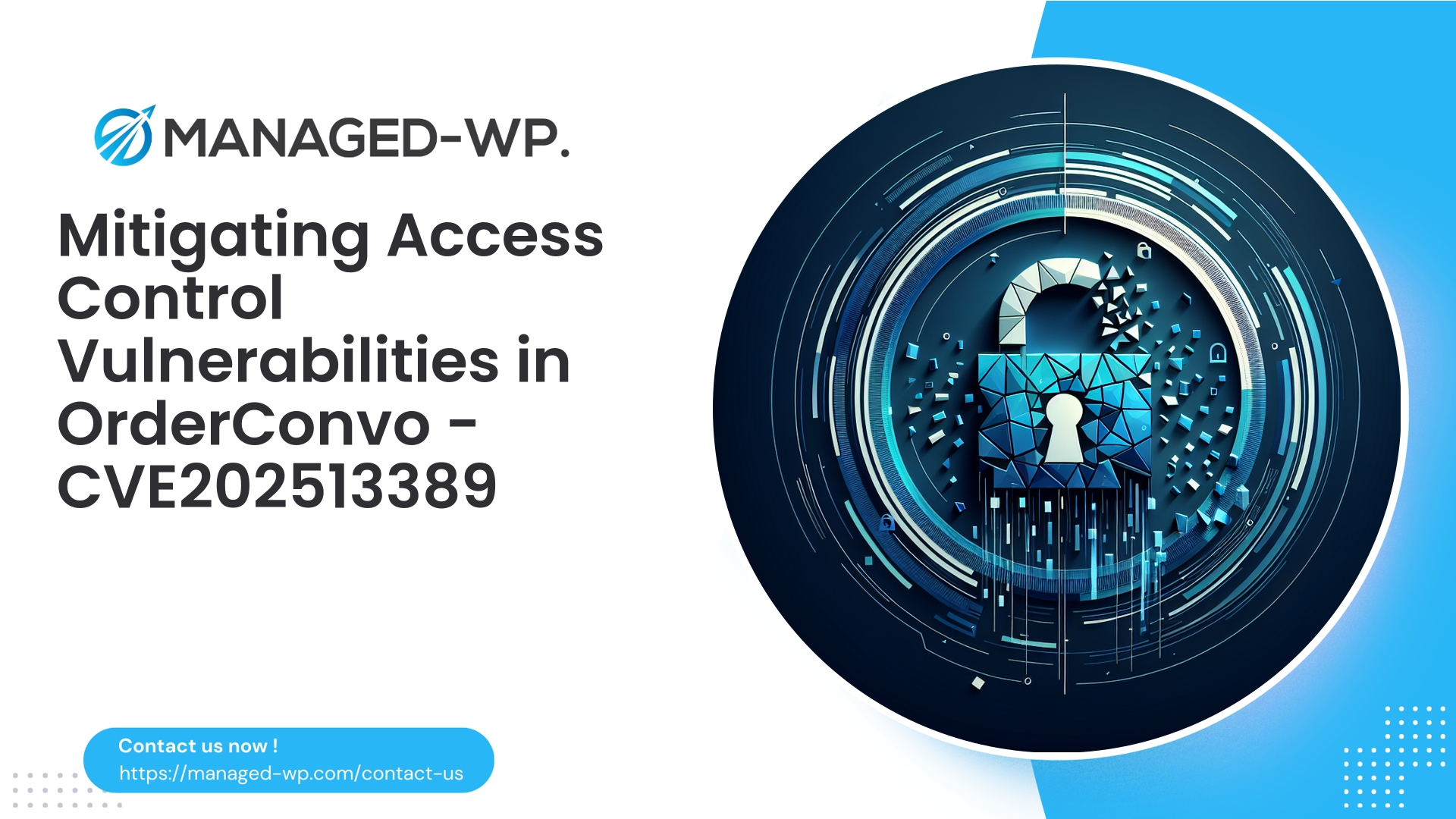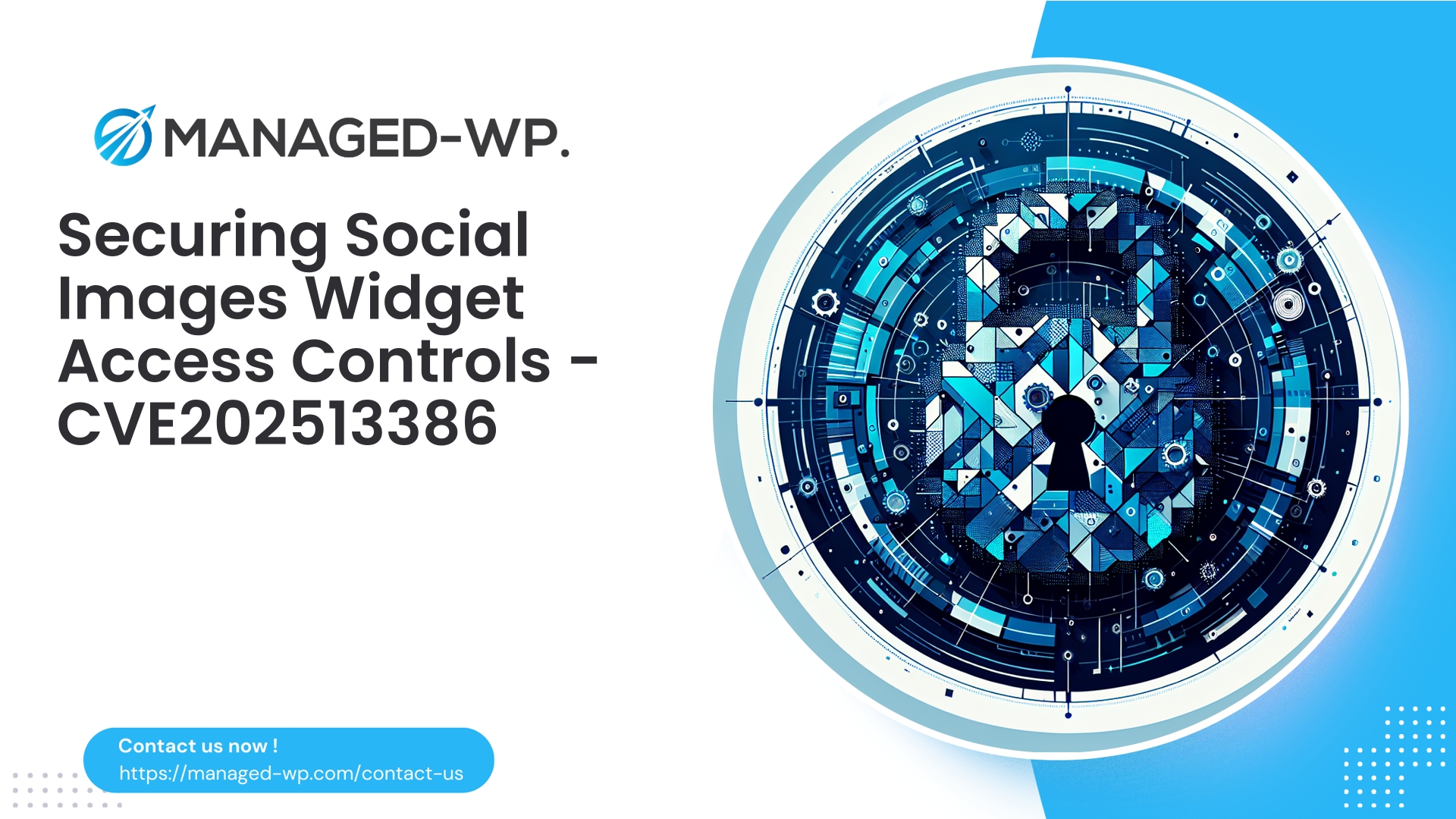| Plugin Name | OrderConvo |
|---|---|
| Type of Vulnerability | Access Control vulnerability |
| CVE Number | CVE-2025-13389 |
| Urgency | Low |
| CVE Publish Date | 2025-11-24 |
| Source URL | CVE-2025-13389 |
Broken Access Control in OrderConvo (<= 14): Critical Guidance for Site Owners and Developers
A significant security vulnerability has been identified in the OrderConvo plugin for WooCommerce (versions <= 14) that permits unauthorized users to access sensitive data. This is a classic case of Broken Access Control — technically classified as CVE-2025-13389. If you operate a WooCommerce store using OrderConvo, you must treat this issue with urgency. Even though its initial severity rating is “low,” the implications can be serious.
In this article, we provide:
- A clear explanation of the vulnerability and its ramifications
- Potential attack vectors and what hackers might attempt
- Methods to verify if your site has been targeted or compromised
- Effective mitigation strategies you can implement immediately
- Developer recommendations to patch the root cause
- The advantages of integrating a managed firewall and Web Application Firewall (WAF) solution
- An invitation to try Managed-WP’s comprehensive protection services
This guidance is presented from the viewpoint of seasoned US-based WordPress security experts, offering straightforward, actionable advice.
Executive Summary
- Vulnerability: Broken Access Control / Missing Authorization in OrderConvo plugin versions <= 14.
- CVE Reference: CVE-2025-13389.
- Impact: Unauthorized users can access restricted order-related information.
- Severity: Rated low (CVSS ~5.3), but sensitive data exposure may elevate the risk.
- Immediate Risk: Attackers may scrape order messages and customer data, posing privacy and regulatory risks.
- Short-Term Mitigation: Disable the plugin, restrict access, or apply WAF-based virtual patching until an official update is released.
- Long-Term Solution: Plugin developers need to implement strict authorization checks, nonce verification, and secure coding practices.
Understanding Broken Access Control in This Context
This vulnerability occurs because certain plugin functions or endpoints return data without validating whether the requestor has permission to view it. Common misconfigurations include:
- AJAX actions (via admin-ajax.php) without capability or nonce checks.
- REST API endpoints missing
current_user_can()or ownership validations. - Public templates or page elements that expose confidential information.
Even small stores’ order communications often contain personally identifiable information (PII) that must be secured rigorously.
Why You Should Take This Vulnerability Seriously Despite Its ‘Low’ Rating
- CVSS scores are generic and don’t always reflect business-specific impacts—exposed customer order data can result in privacy breaches and regulatory issues.
- Attackers commonly chain minor vulnerabilities with others to escalate privileges or data access.
- Automated scans and malicious bots will actively probe for this weakness once publicly known.
Common Attack Scenarios
- Data Harvesting
Attackers automate queries to extract order messages and customer details on a large scale. - Enumeration
Incremental requests reveal valid order and customer data mappings. - Regulatory Exposure
Disclosure of PII such as emails, addresses, or payment notes may cause compliance violations. - Phishing and Further Attacks
Gathered data can enable more targeted social engineering or account takeover attempts.
How to Determine if Your Site Is Vulnerable
- Confirm Plugin Version: If OrderConvo version is 14 or older, assume vulnerability.
- Identify Exposed Endpoints:
- Look for AJAX calls with
orderconvoactions. - Check for REST API routes related to OrderConvo via
/wp-json/. - Search plugin source code for
wp_ajaxandwp_ajax_noprivhooks.
grep -R "orderconvo" wp-content/plugins -n grep -R "wp_ajax" wp-content/plugins/orderconvo -n grep -R "wp_ajax_nopriv" wp-content/plugins/orderconvo -n
- Look for AJAX calls with
- Monitor Server and Access Logs:
# Apache/Nginx log samples grep "/wp-admin/admin-ajax.php" /var/log/nginx/access.log | grep -i "action=orderconvo" grep "/wp-json/" /var/log/nginx/access.log | grep -i "orderconvo"
Watch for high-volume or incremental queries from the same IP addresses.
- Safe Behavior Testing: Use a staging environment to confirm whether sensitive data is exposed without proper authentication. Do not conduct testing on production systems.
Immediate Mitigation Steps
If you maintain a WooCommerce store with OrderConvo <= 14, and an official patch isn’t yet available, take these actions prioritizing protection:
- Deactivate the Plugin
Accessible via WP Admin dashboard or by renaming the plugin folder via SFTP/SSH:mv wp-content/plugins/orderconvo wp-content/plugins/orderconvo.disabled
This halts all plugin functionality but guarantees immediate security.
- Apply Managed-WP WAF Virtual Patching (Recommended)
Block unauthenticated access to plugin AJAX and REST endpoints via custom firewall rules, preventing exploit attempts without disabling functionality. - Restrict Endpoint Access by IP or Basic Auth
Protect plugin REST namespaces using server rules:location ~* ^/wp-json/orderconvo/ { allow 203.0.113.0/24; deny all; } - Patch Plugin Code Locally (Developer Guidance)
Implement strict authorization and nonce verification within AJAX and REST handlers to validate ownership and permissions. - Temporary Alternative Communication
Use secure email or other messaging plugins as interim replacement while remediation is ongoing. - Increase Monitoring and Incident Response
Enhance logging, watch for suspicious access, and prepare to notify stakeholders in case of data exposure.
Managed-WP Web Application Firewall: Virtual-Patching Recommendations
Your Managed-WP WAF can be configured to block or challenge suspicious requests targeting OrderConvo’s vulnerable endpoints. Suggested logic includes:
- Block Unauthenticated AJAX Requests
If request targets/wp-admin/admin-ajax.phpwithaction=orderconvo_*and lacks valid login cookie, block or CAPTCHA. - Protect REST API Namespace
Block or challenge non-whitelisted IPs accessing/wp-json/orderconvo/. - Rate Limit Overactive Clients
Throttle excessive requests from a single IP to prevent data scraping. - Log and Tune
Monitor false positives and gradually tighten rules from challenge to full block as confidence grows.
These managed rules can be quickly deployed by Managed-WP security teams to shield your site immediately.
Incident Response and Forensic Guidance
- Preserve Evidence
Immediately back up logs, database snapshots, and file states before performing changes. - Examine Logs for Patterns
Look for repeated queries with incremental order IDs or unauthorized AJAX calls returning 200 responses. - Check Custom Database Tables
Identify OrderConvo message storage (e.g.,wp_orderconvo_messages) to assess potential data exposure. - Legal and Customer Notification
If PII was exposed, notify legal counsel to comply with breach reporting requirements.
Developer Best Practices: Secure-by-Design Checklist
Plugin authors should incorporate these security measures to prevent such vulnerabilities:
- Principle of Least Privilege
Always verify capabilities withcurrent_user_can()and ownership before disclosing sensitive data. - Nonce and CSRF Protections
Require nonce checks withcheck_ajax_referer()for state-changing AJAX requests. - REST Endpoint Permissions
Usepermission_callbackwithregister_rest_route()to validate user permissions.
Example:
register_rest_route( 'orderconvo/v1', '/messages/(?P<id>\d+)', [
'methods' => 'GET',
'callback' => 'oc_get_messages',
'permission_callback' => function( $request ) {
$order_id = (int) $request['id'];
$order = wc_get_order( $order_id );
if ( ! $order ) {
return new WP_Error( 'no_order', 'Order not found', [ 'status' => 404 ] );
}
$user_id = get_current_user_id();
if ( $user_id === (int) $order->get_user_id() || current_user_can( 'manage_woocommerce' ) ) {
return true;
}
return new WP_Error( 'forbidden', 'Not allowed', [ 'status' => 403 ] );
}
]);
- Sanitize Sensitive Outputs
Mask or exclude PII wherever possible. - Automated Security Testing
Integrate authorization tests into CI pipelines. - Documentation
Publish intended API permissions for site owners and security auditors.
Log and SIEM Hunting Queries
Use these queries to identify suspicious activity related to this vulnerability:
select client_ip, request_uri, count(*) as hits
from access_logs
where request_uri like '%/wp-json/orderconvo%' OR (request_uri like '%admin-ajax.php%' and query_string like '%action=orderconvo%')
group by client_ip, request_uri
having hits > 20
order by hits desc;
grep 'admin-ajax.php' access.log | grep -v 'wordpress_logged_in_' | grep -i 'action=orderconvo'
Flag unusual user agents or repetitive scanning patterns for further investigation.
Hosting Providers and Managed Service Recommendations
- Enforce virtual patching and block vulnerable plugin endpoints globally until customers apply patches.
- Proactively scan hosted sites for vulnerable plugin usage and deploy tailored WAF rules.
- Educate end-customers about risks and mitigation steps clearly and promptly.
- Maintain contact lists of impacted clients and offer forensic assistance as needed.
Incident Response Playbook
- Isolate – Block malicious IPs and patterns immediately.
- Preserve – Secure logs, database snapshots, and file states.
- Investigate – Analyze what data was accessed and timeline.
- Contain and Remediate – Remove or patch plugin, rotate secrets.
- Notify – Follow legal requirements if PII was compromised.
- Recover – Harden site and monitor continuously.
Why Managed-WP’s Firewall and WAF Is Essential
Deploying Managed-WP’s Web Application Firewall offers rapid, robust defense while remediation is underway. Benefits include:
- Virtual patching to block exploit attempts instantly
- Rate limiting and bot mitigation to prevent mass scraping
- Alerting on suspicious activity for quick incident response
- Minimal disruption to legitimate users with precise rules
Managed-WP customers receive expertly managed security policies designed to protect WordPress environments comprehensively.
Site Owner Implementation Checklist
- Verify your OrderConvo plugin version (assume vulnerable if ≤ 14).
- Back up your site and related logs immediately.
- Deactivate the plugin or restrict access to its endpoints.
- Deploy Managed-WP WAF rules to block unauthorized access.
- Monitor logs for enumeration or scraping patterns.
- Coordinate with plugin developers for an official update.
- Follow incident response protocols if data exposure is confirmed.
Security Checklist for Plugin Authors
- Never return sensitive data without rigorous permission checks.
- Avoid publicly accessible AJAX handlers that reveal order data.
- Employ
permission_callbackwithin REST routes properly. - Regularly test endpoints for unauthorized access prevention.
Protect Your WooCommerce Store Now with Managed-WP
Immediate Security with Managed-WP’s Protection Plan
For rapid, hands-off protection, Managed-WP offers an industry-leading Web Application Firewall and managed remediation tailored to WordPress environments. Our MWPv1r1 protection plan starts at just USD20/month and includes:
- Automated virtual patching and advanced role-based traffic filtering
- Personalized onboarding and a step-by-step site security checklist
- Real-time monitoring, incident alerts, and priority remediation support
- Actionable best-practice guides for secrets management and role hardening
Protect My Site with Managed-WP MWPv1r1 Plan
Reasons to Trust Managed-WP
- Immediate coverage against newly discovered plugin and theme vulnerabilities
- Custom WAF rules and instant virtual patching protecting at-risk sites
- Dedicated concierge onboarding and security experts on-call for remediation
Don’t wait for the next security incident. Secure your WordPress site today with Managed-WP — the trusted partner for businesses serious about cybersecurity.
Click above to start your protection now (MWPv1r1 Plan, USD20/month):
https://managed-wp.com/pricing
Take Proactive Action — Secure Your Site with Managed-WP
Don’t risk your business or reputation due to overlooked plugin flaws or weak permissions. Managed-WP provides robust Web Application Firewall (WAF) protection, tailored vulnerability response, and hands-on remediation for WordPress security that goes far beyond standard hosting services.
Exclusive Offer for Blog Readers: Access our MWPv1r1 protection plan—industry-grade security starting from just USD20/month.
- Automated virtual patching and advanced role-based traffic filtering
- Personalized onboarding and step-by-step site security checklist
- Real-time monitoring, incident alerts, and priority remediation support
- Actionable best-practice guides for secrets management and role hardening
Get Started Easily — Secure Your Site for USD20/month:
Protect My Site with Managed-WP MWPv1r1 Plan
Why trust Managed-WP?
- Immediate coverage against newly discovered plugin and theme vulnerabilities
- Custom WAF rules and instant virtual patching for high-risk scenarios
- Concierge onboarding, expert remediation, and best-practice advice whenever you need it
Don’t wait for the next security breach. Safeguard your WordPress site and reputation with Managed-WP—the choice for businesses serious about security.
Click above to start your protection today (MWPv1r1 plan, USD20/month).



















